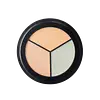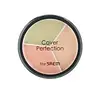What's inside
What's inside
 Key Ingredients
Key Ingredients

No key ingredients
 Benefits
Benefits

 Concerns
Concerns

No concerns
 Ingredients Side-by-side
Ingredients Side-by-side

CI 77891
Cosmetic ColorantCaprylic/Capric Triglyceride
MaskingPolyisobutene
Mica
Cosmetic ColorantIsodecyl Neopentanoate
EmollientDiisostearyl Malate
EmollientHydrogenated Castor Oil
EmollientDipentaerythrityl Hexahydroxystearate/Hexastearate/Hexarosinate
Skin ConditioningMethyl Methacrylate Crosspolymer
Butyloctyl Salicylate
Skin ConditioningCI 77492
Cosmetic ColorantParaffin
PerfumingAluminum Hydroxide
Emollient1,2-Hexanediol
Skin ConditioningSorbitan Sesquioleate
EmulsifyingMicrocrystalline Wax
Emulsion StabilisingCI 77491
Cosmetic ColorantMethicone
EmollientCI 77499
Cosmetic ColorantCaprylyl Glycol
EmollientSqualane
EmollientParfum
MaskingPrunus Amygdalus Dulcis Oil
Skin ConditioningWater
Skin ConditioningBHT
AntioxidantButylene Glycol
HumectantAspalathus Linearis Leaf Extract
Skin ConditioningThymus Vulgaris Extract
PerfumingFoeniculum Vulgare Leaf Extract
HumectantLinalool
PerfumingLimonene
PerfumingHexyl Cinnamal
PerfumingTitanium Dioxide
Cosmetic ColorantCI 77288
Cosmetic ColorantAlpha-Isomethyl Ionone
PerfumingCI 77891, Caprylic/Capric Triglyceride, Polyisobutene, Mica, Isodecyl Neopentanoate, Diisostearyl Malate, Hydrogenated Castor Oil, Dipentaerythrityl Hexahydroxystearate/Hexastearate/Hexarosinate, Methyl Methacrylate Crosspolymer, Butyloctyl Salicylate, CI 77492, Paraffin, Aluminum Hydroxide, 1,2-Hexanediol, Sorbitan Sesquioleate, Microcrystalline Wax, CI 77491, Methicone, CI 77499, Caprylyl Glycol, Squalane, Parfum, Prunus Amygdalus Dulcis Oil, Water, BHT, Butylene Glycol, Aspalathus Linearis Leaf Extract, Thymus Vulgaris Extract, Foeniculum Vulgare Leaf Extract, Linalool, Limonene, Hexyl Cinnamal, Titanium Dioxide, CI 77288, Alpha-Isomethyl Ionone
 Reviews
Reviews

Alternatives
Ingredients Explained
These ingredients are found in both products.
Ingredients higher up in an ingredient list are typically present in a larger amount.
1,2-Hexanediol is a synthetic liquid and another multi-functional powerhouse.
It is a:
- Humectant, drawing moisture into the skin
- Emollient, helping to soften skin
- Solvent, dispersing and stabilizing formulas
- Preservative booster, enhancing the antimicrobial activity of other preservatives
Caprylyl Glycol is a humectant and emollient, meaning it attracts and preserves moisture.
It is a common ingredient in many products, especially those designed to hydrate skin. The primary benefits are retaining moisture, skin softening, and promoting a healthy skin barrier.
Though Caprylyl Glycol is an alcohol derived from fatty acids, it is not the kind that can dry out skin.
This ingredient is also used as a preservative to extend the life of products. It has slight antimicrobial properties.
Learn more about Caprylyl GlycolCi 77491 is also hydrated iron III oxide. It's sole purpose is to give a red/pink hue to products.
Iron III oxides are classified as inorganic chemicals for coloring.
Synthetically created Ci 77491 is considered safer than those naturally found. This is because the synthetically created version may contain less impurities. Iron oxides are generally non-toxic and non-allergenic.
Learn more about CI 77491Ci 77891 is a white pigment from Titanium dioxide. It is naturally found in minerals such as rutile and ilmenite.
It's main function is to add a white color to cosmetics. It can also be mixed with other colors to create different shades.
Ci 77891 is commonly found in sunscreens due to its ability to block UV rays.
Learn more about CI 77891